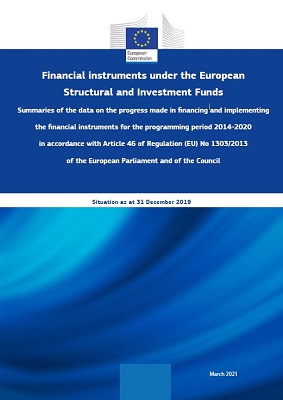New data confirms growth in financial instruments

The European Commission has published its annual report summarising the data on the use of ESIF financial instruments for the period until end December 2019.
By the end of 2019, more than EUR 15 billion of financing was provided to recipients, primarily SMEs, thanks to the support of the Funds, with each EUR 1 from the EU budget resulting on average in more than EUR 3 in the real economy.
This year’s summaries include also some preliminary data on the use of financial instruments to address the COVID-19 pandemic, where financial instruments played an important role. Detailed information on this topic will be included in the next summaries, which will be published by the end of November 2021.
The summaries present data on the progress made in financing and implementing financial instruments (FIs) supported by European Structural and Investment Funds (ESIF) in the 2014-2020 programming period as of 31 December 2019. They are based on data reported by the managing authorities in accordance with Article 46 of Common Provisions Regulation (EU) No 1303/2013 of the European Parliament and of the Council (CPR), the Commission Implementing Regulation (EU) No 821/2014 and Fund-specific regulations.
The publication’ key preliminary findings that show how FIs supported by ESIF played a major role in providing fast and flexible support to SMEs as part of the response to the COVID-19 pandemic are:
- FIs are implemented using all ESI Funds in 25 Member States,
- By the end of 2019, the total programme contributions committed to FIs were nearly EUR 23.5 billion (EUR 22.1 billion at the end of 2018) of which EUR 17.2 billion was ESIF,
- The total number of planned or operational FIs stood at 756,
- From the beginning of the 2014-2020 period, almost EUR 11.1 billion of programme contributions had been paid to FIs (EUR 9.0 billion at the end of 2018), including EUR 8.5 billion of ESIF (around 50% of committed ESIF amounts),
- Around EUR 6.3 billion had been invested in or committed for final recipients (EUR 3.7 billion at the end of 2018), of which EUR 4.7 billion was ESIF,
- During 2019, the new amounts invested in or committed for final recipients (EUR 2.6 billion) exceeded the new amount paid to FIs (EUR 2.1 billion), demonstrating that most of the FIs are operational and the liquidity provided through advances is used as intended.
The publication confirms that FIs supported by ESIF played a major role in providing fast and flexible support to SMEs as part of the response to the COVID-19 pandemic.
- ERDF FIs allocated EUR 4.7 billion for working capital in the COVID-19 context, which is more than double what the Member States (MSs) allocated to working capital grants. Based on payment claims submitted, at least EUR 4.2 billion reached final recipients since the beginning of the crisis, in all MSs using FIs and the UK,
- Despite of COVID-19 crisis, ESF FIs continued to make progress. Preliminary data from payment claims show that at least additional EUR 55.5 million was paid at the level of final recipients. DE contributed most to the increase, but also PL, LV, IT and BG reported using FIs during the pandemic,
- Eight EAFRD managing authorities in six MSs (ES, IT, LT, PL, PT, RO) introduced or amended FIs under rural development programmes to provide dedicated working capital finance to address the economic impact of the COVID-19 pandemic (out of the total 30 RDPs having FIs),
- The managing authority for the sole FI supported by EMFF has made it possible for the final recipients in EE to benefit from decreased interest rates, including for the agreements already concluded, retroactively from April 2020. As these summaries cover the period until the end of 2019, they do not yet include the data on progress made in the COVID-19 context. The full details would be included in the next summaries, which will be published by the end of November 2021.
The three most common Thematic Objectives according to commitments to FIs in the
funding agreements remain:
- TO3 ‘Enhancing the competitiveness of small and medium-sized enterprises (SMEs)’ – 57.3%,
- TO4 ‘Supporting the shift towards a low-carbon economy in all sectors’ – 15.6%,
- TO1 ‘Strengthening research, technological development and innovation’ – 14.5%.
The annual summaries report is divided into chapters by the different ESI Funds: ERDF/CF, ESF/YEI, EAFRD and EMFF. Data on FIs were originally supposed to be submitted by programme authorities by the end of May 2020. However, the regulatory deadline was postponed until the end of September 2020, in order to make it possible to focus all the efforts on addressing the COVID-19 crisis. As in line with Article 46(4) CPR the summaries are published within six months of the deadline, this year’s publication took place in March 2021. It is published here on the fi-compass website.


